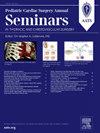先天性心脏病患者血液循环确定死亡后的捐赠:我们应该接受吗?
Q2 Medicine
引用次数: 0
摘要
缺乏年龄和体型合适的供体阻碍了儿童心脏移植。在某些年轻的患者群体中,机械循环支持作为心脏移植的桥梁可能会有不良的结果,再加上供体的稀缺,增加了等待心脏移植的儿童的发病率和死亡率。循环测定死亡(DCDD)后捐赠的心脏移植已被用于增加儿童同种异体移植供体的数量。最初的方法包括直接获取和灌注受体(DPP),以及最近的非原位恒温机器灌注(NMP)。然而,NMP是昂贵的,而且这种方法不允许在移植前对供体器官的负荷状态进行功能评估。NMP也不适用于最小的儿科患者。另一种方法,常温区域灌注(NRP),可以克服NMP的局限性。NRP是一种胸腹动态原位器官评估方法,在确定循环死亡后进行申报。原位组织灌注是在不违反“死亡供体规则”的前提下,根据严格的预先规定的指导方针,使用旁路电路建立可移植器官。首例使用NRP的儿童DCDD心脏移植手术于2019年进行,从那时起,几个中心报告了巨大的成功。对脑再灌注的伦理关注尚未得到临床数据的证实。利用DCDD供体可以极大地扩大先天性心脏病(CHD)的供体池。本文章由计算机程序翻译,如有差异,请以英文原文为准。
Donation After Circulatory Determination of Death in Congenital Heart Disease: Should We Embrace?
The lack of donors that are age and size appropriate has compromised pediatric heart transplantation. There may be poor outcomes following mechanical circulatory support as a bridge to heart transplant in certain younger patient cohorts, which combined with the scarcity of donors, increases the morbidity and mortality in children waiting for a heart transplant. Transplantation of hearts donated after circulatory determination of death (DCDD) has been utilized to increase the pool of pediatric donor allografts. The original approach included direct procurement and perfusion in the recipient (DPP), and recently ex-situ normothermic machine perfusion (NMP). However, NMP is expensive, and this methodology does not allow for a functional assessment in a loaded state of the donor organ prior to transplantation. NMP is also not available to the smallest pediatric patients. An alternative method, normothermic regional perfusion (NRP), can overcome the limitations of NMP. NRP is a thoraco-abdominal dynamic in-situ organ assessment method and is instituted following declaration after determination of circulatory death. In-situ tissue perfusion is established to the transplantable organs using a bypass circuit based on strict, prespecified guidelines that do not violate the “dead donor rule.”
The first pediatric DCDD heart transplant using NRP was performed in 2019, and since then, several centers have reported immense success. Ethical concerns for cerebral reperfusion have not been substantiated by clinical data. Utilization of DCDD donors can vastly expand the donor pool in congenital heart disease (CHD).
求助全文
通过发布文献求助,成功后即可免费获取论文全文。
去求助
来源期刊

Pediatric Cardiac Surgery Annual
Medicine-Surgery
CiteScore
3.80
自引率
0.00%
发文量
7
期刊介绍:
The Pediatric Cardiac Surgery Annual is a companion to Seminars in Thoracic and Cardiovascular Surgery . Together with the Seminars, the Annual provides complete coverage of the specialty by focusing on important developments in pediatric cardiac surgery. Each annual volume has an expert guest editor who invites prominent surgeons to review the areas of greatest change in pediatric cardiac surgery during the year. Topics include 1) Complete Atrioventricular Canal; 2) New Concepts of Cardiac Anatomy and Function -- The Helical Heart; 3) Valve Reconstruction (Replacement) in Congenital Heart Disease; 4) Evolving Developments in Congenital Heart Surgery.
 求助内容:
求助内容: 应助结果提醒方式:
应助结果提醒方式:


